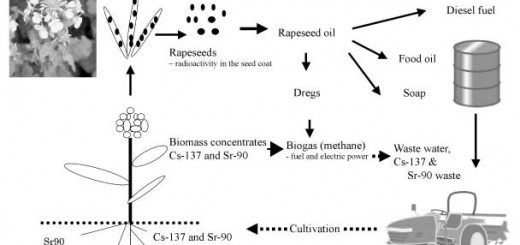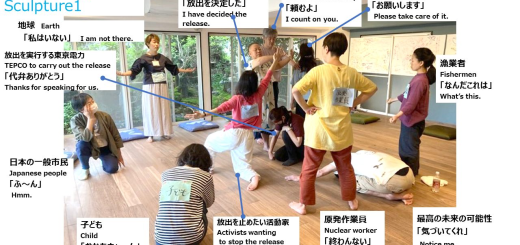Report of the Iitate Villagers’ Early-stage External Radiation Exposure Assessment Project Nuke Info Tokyo No. 160
Research Reactor Institute, Kyoto University
As we reported in the March/April 2013 issue of Nuke Info Tokyo (No. 153), we started on a project entitled “Assessment of the Initial Radiation Exposure to Residents in Iitate village up to Evacuation after the Fukushima-1 NPP Accident” in autumn 2012, sponsored by the Japanese Ministry of the Environment. (The expression early-stage exposure here refers to the exposure dose received by Iitate villagers during the several months between the time when the village was radioactively contaminated in March 2011 and the evacuation of the villagers after the village was designated as a planned evacuation zone.) In FY2012, we developed a method for estimating the external radiation exposure received by the villagers on the hypothesis that they remained in the village continually and through an estimation of the radionuclide depositions at the location of every household in Iitate Village using the airborne survey data available from the U.S. Department of Energy National Nuclear Security Administration (NNSA). In FY2013, we interviewed villagers to determine the specific radioactive exposure of individuals, to learn about what activities they were engaged in and where they were during the several months before the evacuation. Data was collected from 1,812 villagers, 30% of the total population of Iitate Village, which was originally home to about 6,000 people. We determined how much early-stage external radiation exposure they received. This paper is a brief summary of this project.
Summary of research activities in FY2012
Firstly, we analyzed the airborne survey data available from NNSA by means of the geographic information system (GIS) technology, and created a Cesium-137 (Cs-137) deposition contamination map of the entire Iitate Village area. Next, we determined the longitude and latitude of every household in Iitate Village (about 1,700 households in total), using commercially available housing maps and Japanese Geographical Survey Institute maps. We determined the amount of Cs-137 deposition at the location of each house in the village by combining the location data and contamination map. In the village, the average Cs-137 deposition was 890 kBq/m2 and the highest Cs-137 deposition was 2,360 kBq/m2.
We calculated the depositions of radionuclides having relatively short half-lives, such as radioactive Iodine-131, based on the data from soil sampled at the end of March 2011, hypothesizing that the ratio of these depositions to the Cs-137 deposition was constant across the village. We also hypothesized that the depositions of radionuclides in Iitate Village occurred at one time, 18:00, March 15, 2011, and calculated changes in the air radiation dose rate thereafter, along with cumulative air dose. The result of the calculation was that at a location where the Cs-137 deposition was 1,000 kBq/m2, the cumulative air dose (air absorbed dose) at the height of one meter from the ground reached 32.6 mGy at the end of June 2011.
Interview survey of Iitate villagers
In early July 2013, we established an office near the Japan Railway Fukushima Station, and began to carry out the Iitate Village Initial Dose Assessment Project. Project members visited one member of each Iitate family and collected information about the behavioral patterns of all of the person’s family members during the period between March 11 and July 31. Requests for interviews were made in three forms: by mailing a written request, visiting villagers at the temporary housing to which they had evacuated, and by making contact by telephone when the villagers were known to project members. Before the end of October 2013, the project had collected information on the behavioral patterns of 1,812 villagers from 496 families.
Of the villagers whose behavioral information was collected, 16% were 20 years of age or under, 42% were from 20 to 50, and 42% were 50 or over 50. Because many of those interviewed at the temporary housing were elderly, we gained the impression that the group we interviewed might be biased toward older villagers. Nevertheless, of the total Iitate population of 6,132 people, 18% were 20 years of age or under, 44% were between 20 and 50, and 38% were 50 or over (as of March 3, 2011), indicating that the interviewed group was similar to the actual Iitate population in terms of age distribution. We consider that the results of our interview survey correctly represent the entire population of the village.
Assessment of early-stage external radiation exposure
We assessed the external radiation exposure received by the 1,812 villagers whose behavioral information for the period between March 15 and July 31, 2011 was obtained. The following are the major hypotheses used for the assessment.
1. Only the external exposure received during the time people were actually present in Iitate Village was counted and the exposure outside the village was hypothesized to be zero.
2. The villagers were hypothesized to have been resident in their houses when they were in Iitate Village; they were hypothesized to have been indoors for 16 hours and outdoors for 8 hours daily. The indoor radiation reduction factor 0.4 was used.
3. As the conversion factor for determining effective dose based on air absorption dose (Sv/Gy ratio), 0.8 was used for children under 10 years old and 0.7 for people of 10 years of age or over.
The early-stage external radiation exposure estimated for the 1,812 villagers was distributed as shown in Figure 1. The average dose was 7.0 mSv, and the maximum was 23.5 mSv, received by a 60-year-old male. Table 1 shows the average doses among different age groups. The dose received by children under 10 years old was low, indicating the fact that children were evacuated earlier than adults. In comparison between males and females, the average male dose was 7.5 mSv, which was slightly higher than the average female dose of 6.5 mSv.
Iitate Village is divided into 20 administrative districts (Figure 2). Table 2 shows the average dose in the individual districts. In the Nagadoro, Hiso and Warabidaira districts, where contamination was high, people received greater exposure. In Nimaibashi–Sugaya and Okura, where contamination was relatively low, the dose received by villagers was also low.
 |
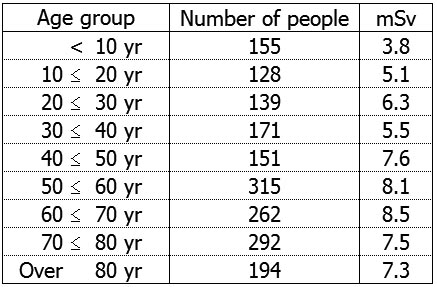 |
| Figure 1. Cumulative external dose up to July 31, 2011, mSv | Table 1. Average external dose by age group |
Iitate villagers’ provisional return to the village
As we proceeded with the interview survey, we learned that many of those who relocated swiftly after the March 11 earthquake and the nuclear accident temporarily returned to Iitate Village after a while and then evacuated again after the village was designated a planned evacuation zone. Figure 3 is a graph of the percentage of villagers who were in the village. This graph explicitly indicates an interesting tendency in the change in population in the village; namely, those who evacuated immediately after the earthquake started to return to the village after March 21 and evacuated again after April 22, when the village was designated a planned evacuation zone. If the planned evacuation zone had been designated one month earlier, a major part of the early-period exposure in the village would have been prevented.
The reasons for the return of those who had evacuated quickly were as follows:
・The life in evacuation areas was difficult in many ways.
・Villagers were assured by hearing lectures organized by the government that the radioactive contamination would not pose a problem.
・Companies in Iitate Village requested employees to return in order to restart business.
Let us note that March 21 was the day when Prof. Shunichi Yamashita, who had come from Nagasaki University to Fukushima as the prefectural risk advisor and who is well known for stating that “Radioactivity is nothing to worry about if you keep smiling,” delivered his first talk in Fukushima.
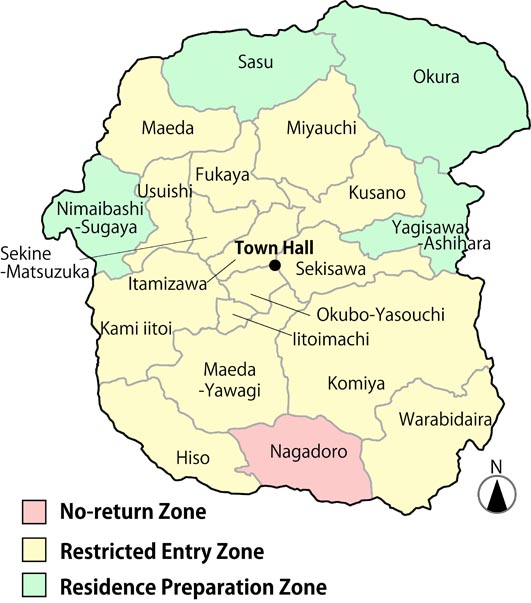 |
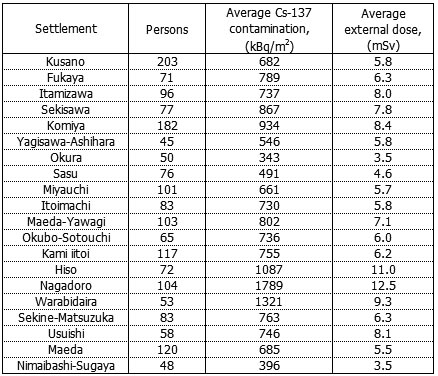 |
| Figure 2. The twenty administrative districts in Iitate Village |
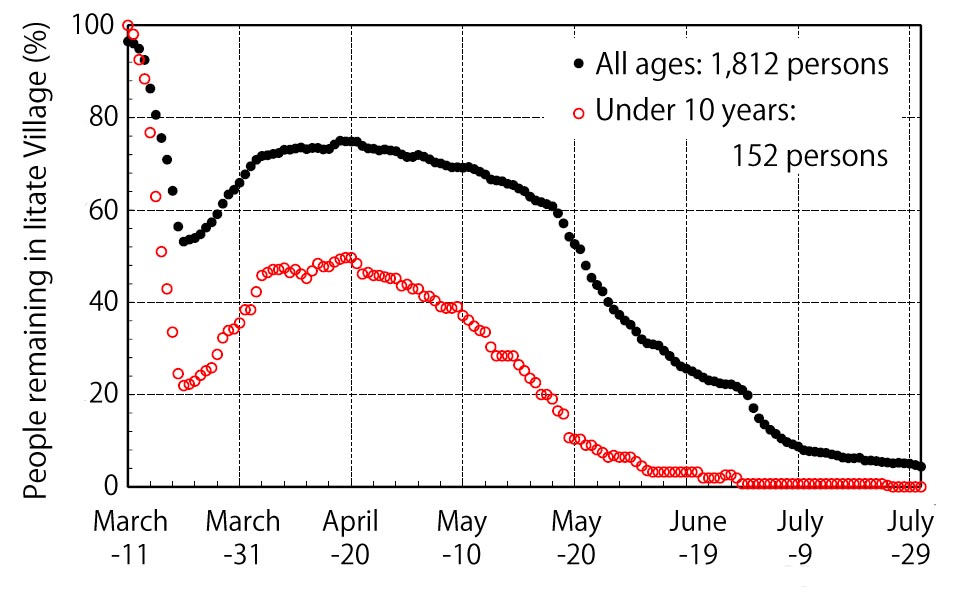 |
| Figure 3. Percentage of Iitate villagers who remained in the village after March 11, 2011 |
Comparison with the Fukushima Health Management Survey
It was surely the Japanese government’s job to assess the radiation dose received by people in the areas surrounding the Fukushima Daiichi Nuclear Power Station accident, but this responsibility was entirely thrown over to the Fukushima Prefecture at an early stage after the accident. The notorious Fukushima Health Management Survey (FHM survey) is being conducted as a result. In the FHM survey, the early-stage external radiation exposure has been assessed on the basis of the results of an activity questionnaire survey filled out by Fukushima residents. This questionnaire is used as the basic survey. Based on the FHM survey report, the average exposure of the 3,102 Iitate villagers who responded to the questionnaire was an estimated average dose of 3.6 mSv, which is about half our estimation. The differences between our survey and the FHM survey in the estimation of exposure dose are as follows:
1. Estimation of air dose rate: The FHM survey used the terrestrial survey data collected by the Japanese Ministry of Education, Culture, Sports, Science and Technology (MEXT). The MEXT data was collected more directly than the data taken by the airborne survey, but the MEXT measurements are fewer during the early stage immediately after the accident, during the time when people were exposed to large doses.
2. Collection of activity information of residents and the handling of hours: We interviewed Iitate villagers and collected the information concerning their residence and activities after March 11, 2011 on a daily basis. In the FHM survey, the questionnaire asked for more detailed information on peoples’ activities; residents were asked to enter where they had stayed and what they had done on an hourly basis.
3. Period of cumulative exposed dose calculation: We accumulated the exposure data of residents up to July 31, 2011, while the FHM survey covered the period up to July 11, 2011.
4. Exposure outside Iitate Village: Our estimates do not include exposure villagers may have received outside Iitate Village, but the scope of the FHM survey includes the entire area of Fukushima Prefecture, and the FHM survey includes the dose received after residents evacuated from Iitate Village.
In consideration of these differences in estimation methods, the author has the frank impression that our estimation results, which are double those of the FHM survey, are more consistent with each other than we had expected. We used many hypotheses in the estimation process and the results include many uncertainties. The specific reasons for the differences between our results and those of the FHM survey is a matter we intend to examine in the future.
Cancer death risk assessment based on early-stage exposure
What we are principally concerned about regarding the influence of the average roughly 7 mSv exposure dose is an increase in the number of cancer cases in the future. There have been many discussions about the relationship between exposure and cancer risk (dose and effects). The linear model, in which the cancer probability increases in proportion to exposure even when the exposure is small, is the model most consistent with the actual observation data, and best withstands criticism. Based on the linear model, we discuss here the risk of cancer in association with the early-stage external radiation exposure of Iitate villagers. The expected number of cancer deaths increases in proportion to the collective dose. The collective dose is the sum of individual doses, and has the unit man-Sv. If 1,000 people each received an exposure of 1 mSv, the collective dose is 1,000 man-mSv, which is 1 man-Sv. As for the 1,812 Iitate villagers we surveyed for the period ending on July 31, 2011, the collective exposure was 12.6 man-Sv. When this estimate is applied to the entire Iitate Village population (6,132), the collective exposure is 42.7 man-Sv. Supposing that the risk factor for radiation-induced cancer death is 0.055 per Sv, as per the International Commission on Radiological Protection (ICRP) Recommendations, the future excess cancer deaths in Iitate Village will be 2.3 cases. According to research by Dr. John W. Gofman of the United States, the risk factor of radiation-induced cancer death is 0.4 per Sv, and when this factor is applied, the future number of excess cancer deaths is 17. Today, one out of two Japanese contracts cancer and one out of three Japanese dies of cancer. Therefore, of the population of Iitate Village of roughly 6,000 people, about 2,000 would likely die of cancer even if the nuclear accident had not occurred. Based on our risk assessment, the early-stage external radiation exposure in Iitate Village will add two to seventeen extra cancer deaths, or will result in about a 0.1% to 1% increase in cancer deaths.
(I presented the research results in this paper at the Reviewer Meeting of the Ministry of Environment Research Grants in December 2013. In response to the presentation, an expert reviewer committee member commented: “There are doubts about the appropriateness of estimation of cancer deaths using scientifically uncertain risk factors in the low-level exposure range.” It seems that discussion using specific death tolls is considered inconvenient for the “risk communication” promoted by the Japanese government.)
******
Although there were many problems and challenges involved in this research, I find it significant that we were able to independently assess the early-stage external radiation exposure of people in Iitate Village. As for the thyroid exposure due to the intake of radioactive Iodine-131, we intend to use a different method from that used for external exposure (and this will be investigated in research that is separate from the research sponsored by the Ministry of the Environment).

